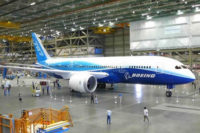Every person chases a dream, but only the Dream Chaser (DC) spacecraft system has a final destination of the International Space Station (ISS) nearly 250 miles above the Earth. Sometime in late 2020, the DC will make its initial vertical launch on an Atlas V 5 rocket, enter low-Earth orbit to resupply the ISS with pressurized and unpressurized cargo, and then autonomously land horizontally on a conventional runway. It will repeat this process at least five more times over the next few years.
Sierra Nevada Corp. is the owner and operator of the DC, but has partnered with several aerospace companies, NASA centers and universities to design, assemble and test the spacecraft in Louisville, CO. Lockheed Martin, for example, constructed the spacecraft’s airframe and verified its human rating.
Boeing Phantom Works built some early test platforms, and AdamWorks provided composite materials. Systems engineering was overseen by Maxar Technologies, while the Charles Stark Draper Laboratory helped with guidance and navigation, and Aerojet focused on reaction control system technology.
The Southwest Research Institute, headquartered in San Antonio, used a test system from SAKOR Technologies Inc. to verify the accuracy of the DC atmospheric flight control system. SAKOR provided a custom DynoLAB data acquisition system to exercise DC’s
control mechanisms and simulate its flight from atmospheric interface to landing.
DynoLAB offers users complete automation of all types of test cycles used in performance, durability and quality control testing. The custom model featured seven dynamometers, each of which simulated dynamic loads on a specific control surface, and communicated directly with the atmospheric flight control system via a built-in MIL-STD-1553B avionics bus.
Southwest Research engineers sent test profiles to the atmospheric flight controller and simulated force feedback from each control surface. They then used this information to verify the spacecraft’s overall design performance, as well as its response to physical forces typically experienced in standard and extreme flight conditions.
“The [DynoLAB] system pushed the design envelope to ensure [that] the [spacecraft’s] atmospheric control
system [will] handle anything it may have thrown at it,” says Randal Beattie, president of SAKOR. “We’re proud to have been selected for this project, which is critical to our nation’s next-generation space capabilities.”
Last December, Sierra Nevada won NASA approval to begin full-scale production of the DC. Designed specifically for low-Earth orbit destinations, including the Hubble Space Telescope, the spacecraft can be reused up to 15 times.
SAKOR makes three types of AC dynamometers. The four-quadrant AccuDyne series includes 5-kilowatt to 3-megawatt models used for testing active (engines, electric motors) and passive (transmissions, generators, alternators) components. Its MicroDyne units are designed for testing small motors and components with 100 watts to 5 kilowatts of power. Small engine dynamometers help engine manufacturers comply with engine testing procedures required by emission standards contained in 40 CFR Part 1065.
Since 1987, SAKOR has designed and built test instrumentation systems for manufacturers in many markets. Customers include companies in automotive, military, aerospace, marine, heavy equipment, electric motors, performance racing and consumer appliances.
For more information, call 989-720-2700 or visit www.sakor.com.








